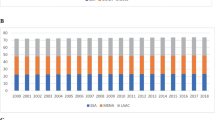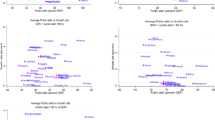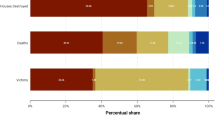Abstract
This paper empirically investigates the three-way linkages amongst foreign direct investment (FDI), shadow economy and institutional quality by applying the panel dynamic simultaneous-equation modelling approach for a sample of 19 developing Asian countries over the period of 2002–2015. The empirical results by two-step System GMM show that institutional quality attracts inward FDI and FDI in its turn improves institutional quality, institutional quality is not only the cause but also the consequence of the shadow economy, and FDI inflows help reduce shadow economies though the channel of institutional improvement and lower shadow economies – which increase institutional quality – encourage FDI inflows. The empirical insights suggest helpful policy implications to deal with these dynamics simultaneously.


Similar content being viewed by others
References
Abotsi A (2016) Theory of foreign direct investment and corruption. Int J Asian Social Science 6(6):359–337
Acemoglu D, Johnson S, Robinson J (2005) Institutions as a fundamental cause of long-run growth, vol 1
Ades A, Tella R (1999) Rents, competition, and corruption. Am Econ Rev 89:982–993
Adsera A, Boix C, Bayne M (2003) Are you being served? Political accountability and quality of government. J Law Econ Org 19:445–490
Agosin M, Machado R (2005) Foreign Investment in Developing Countries: does it crowd in domestic investment? Oxf Dev Stud 33(2):149–162
Aleksynska M, Havrylchyk O (2013) FDI from the south: the role of institutional distance and natural resources. Eur J Polit Econ 29:38–53
Ali M, Bohara A (2017) How does FDI respond to the size of shadow economy: an empirical analysis under a gravity model setting. Int Econ J 31(2)
Ali F, Fiess N, Macdonald R (2011) Climbing to the top? Foreign direct investment and property rights. Econ Inq 49:289–302
Alm J, Embaye A (2013) Using dynamic panel methods to estimate shadow economies around the world, 1984–2006. Public Finance Review 41(5):510–543
Alonso JA, Garcimartin C (2013) The determinants of institutional quality. More on the debate. J Int Dev 25(2):206–226
Arellano M, Bond S (1991) Some tests of specification for panel data: Monte Carlo evidence and an application to employment equations. Rev Econ Stud 58(2):277–297
Arellano M, Bover O (1995) Another look at the instrumental variable estimation of error-components models. J Econ 68(1):29–51
Asiedu E (2006) Foreign direct Investment in Africa: the role of natural resources, market size, government policy, institutions and political instability. World Econ 29(1):63–77
Asiedu E, Lien D (2011) Democracy, foreign direct investment and natural resources. J Int Econ 84:99–111
Bajada C, Schneider F (2005) The shadow economies of the Asia-Pacific. Econ Rev 10(3):379–401
Bandyopadhyay S, Sandler T, Younas J (2014) Foreign direct investment, aid, and terrorism. Oxf Econ Pap 66(1):25–50
Barro R (1997) The determinants of economic growth: a cross-country empirical study. MIT Press, Cambridge
Bellos S, Subasat T (2011) Corruption and FDI: a panel gravity model approach. Bull Econ Res 64(4):565–574
Berdiev A, Pasquesi-Hill C, Saunoris J (2015) Exploring the dynamics of the shadow economy across US states. Appl Econ 47(56):6136–6147
Bevan A, Estrin S, Meyer K (2004) Foreign investment location andinstitutional development in transition economies. Int Bus Rev 13:43–64
Blackburn K, Bose N, Capasso S (2012) Tax evasion, the underground economy and financial development. J Econ Behav Organ 83(2):243–253
Blomström M, Fors G, Lipsey RE (1997) Foreign direct investment and employment: home country experience in the United States and Sweden. Econ J 107:1787–1797
Blundell R, Bond S (1998) Initial conditions and moment restrictions in dynamic panel data models. J Econ 87(1):115–143
Boeri T, Garibaldi P (2002) Shadow activity and unemployment in a depressed labor market. In: Paper presented at the EPR discussion papers, p 3433
Borensztein E, De Gregorio J, Lee J-W (1998) How does foreign direct investment affect economic growth? J Int Econ 45(1):115–135
Boustanifar H (2014) Information acquisition, foreign bank entry, and credit allocation. The Quarterly Review of Economics and Finance 54(3):324–336
Brahim M, Rachdi H (2014) Foreign direct investment, institutions and economic growth: evidence from the MENA region. J Reviews Global Economics 3:328–339
Brainard SL (1997) An empirical assessment of the proximity-concentration trade-off between multinational sales and trade. Am Econ Rev 87(4):520–544
Broadman HG, Sun X (1997) The distribution of foreign direct investment in China. World Econ 20:339–361
Broms, R. (2011). Taxation and government quality: the size, the shape, or just Europe 300 years ago? . Paper presented at the Quality of Governance Working Paper Series 2011:16, December 2011, ISSN 1653–8919
Buchanan B, Le Q, Rishi M (2012) Foreign direct investment and institutional quality: some empirical evidence. Int Rev Financ Anal 21:81–89
Busse M, Hefeker C (2007) Political risk, institutions and foreign direct investment. Eur J Polit Econ 23(2):397–415
Choe J (2003) Do foreign direct investment and gross domestic investment promote economic growth? Rev Dev Econ 7(1):44–57
Chong A, Zanforlin L (2000) Law tradition and institutional quality: some empirical evidence. J Int Dev 12(8):1057–1068
Chowdhury A, Mavrotas G (2006) FDI and growth: what causes what? World Econ 29(1):9–19
Coughin CC, Segev E (2000) Foreign direct investment in China: a spatial econometric study. World Econ 26:1–23
Dang D (2013) How foreign direct investment promote institutional quality: evidence from Vietnam. J Comp Econ 41(4):1054–1072
Daniele V, Marani U (2011) Organized crime, the quality of local institutions and FDI in Italy: a panel data analysis. Eur J Polit Econ 27:132–142
Davidescu AA, Strat VA (2015) Shadow economy and foreign direct investments: an empirical analysis for the case of Romania. Ecoforum 4(2):110–118
De Soto H (1989) The other path: the invisibly revolution in the third world. Harper and Row, New York
De Soto H (2000) The mystery of capital: why capitalism triumphs in the west and fails. Basic Books, New York
Dell’Anno R, Solomon OH (2008) Shadow economy and unemployment rate in USA: is there a structural relationship? An empirical analysis. Appl Econ 40:2537–2555
Dell'Ariccia G, Marquez R (2004) Information and bank credit allocation. J Financ Econ 72(1):185–214
Demsetz H (1974) Toward a theory of property rights. In: G. C (ed) Classic papers in natural resource economics. Palgrave Macmillan, London
Doblas-Madrid A, Minetti R (2013) Sharing information in the credit market: contract-level evidence from U.S. firms. J Financ Econ 109(1):198–223
Dollar, D. (2015). What institutions do Asian countries need to keep growing? . Paper presented at the Pacific trade and development conference, Singapore
Dreher A, Schneider F (2010) Corruption and the shadow economy: an empirical analysis. Public Choice 144(1):215–238
Dreher A, Kotsogiannis C, McCorriston S (2009) How do institutions affect corruption and the shadow economy? Int Tax Public Financ 16(6):773–796
Du J, Lu Y, Tao Z (2008) Economic institutions and FDI location choice: Evidence from US multinationals in China. J Comp Econ 36:412–429
Dunning JH (1980) Toward an eclectic theory of international production: some empirical tests. J Int Bus Stud 11(1):9–31
Elgin C, Oyvat C (2013) Lurking in the cities: urbanization and the informal economy. Struct Chang Econ Dyn 27:36–47
Fabry N, Zeghni S (2006) How former communist countries of Europe may attract inward foreign direct investment? A matter of institutions. Communist and Post-Communist Studies 39:201–219
Fan JPH, Morck R, Xu LC, Yeung B (2009) Institutions and foreign direct investment: China versus the rest of the world. World Dev 37(4):852–865
Farla K, Crombrugghe D, Verspagen B (2014) Institutions, foreign direct investment, and domestic investment: crowding out or crowding in? World Dev 88:1–9
Fosu S (2014) Credit information, consolidation and credit market performance: Bank-level evidence from developing countries. Int Rev Financ Anal 32:23–36
Frey BS, Pommerehne WW (1984) The hidden economy: state and prospects for measurement. Rev Income Wealth 30:1), 1–1),23
Friedman E, Johnson F, Kaufmann D, Zoido-Labton P (2000) Dodging the grabbing hand: the determinants of unofficial activity in 69 countries. J Public Econ 76(4):459–493
Fugazza M, Jacques JF (2003) Labor market institutions, taxation and the underground economy. J Public Econ 88:395–418
Fukumi A, Nishijima S (2010) Institutional quality and foreign direct investment in Latin America and the Caribbean. Appl Econ 42(14):1857–1864
Giles DE (1999) Measuring the hidden economy: implications for econometric modelling. Econ J 109:370–380
Glaeser, E. L., La Porta, R., & Lopez-de-Silanes, F. (2004). Do Institutions Cause Growth? . Journal of Economic Growth, . Do Institutions Cause Growth? . J Eco Growth, 271–303., 9(3), 271–303
Grosse R, Trevino L (2005) New institutional economics and FDI location in central and Eastern Europe. Manag Int Rev 45(2):123–145
Gupta MS, Abed MGT (2002) Governance, corruption, and economic performance. International Monetary Fund
Haggard S (2004) Institutions and growth in East Asia. Stud Comp Int Dev 38(4):53–81
Hallerberg M, Wolff GB (2008) Fiscal institutions, fiscal policy and sovereign risk premia in EMU. Public Choice 136(3–4):379–396
Hamuda AM (2013) Ardl investment model of Tunisia. Theoretical and Applied Economics 20(2):57–68
Hansen H, Rand J (2006) On the causal links between FDI and growth in developing countries. World Econ 29(1):21–41
Harris H, Sollis R (2003) Applied time series modelling and forecasting. Wiley, West Sussex
Hassan, M., & Schneider, F. (2016). Size and Development of the Shadow Economies of 157 Countries Worldwide: Updated and New Measures from 1999 to 2013
Herrera-Echeverri H, Haar J, Estévez-Bretón JB (2014) Foreign direct investment, institutional quality, economic freedom and entrepreneurship in emerging markets. J Bus Res 67(9):1921–1932
Heyman F, Sjholm F, Tingvall P (2007) Multinationals, cross-border acquisitions and wage dispersion. Can J Econ 44(2):627–650
Hoffman RC, Munemo J, Watson S (2016) International franchise expansion: the role of institutions and transaction costs. J Int Manag 22(2):101–114
Huynh CM, Nguyen TL (2019) Fiscal policy and shadow economy in Asian developing countries: does corruption matter? Empir Econ. https://doi.org/10.1007/s00181-019-01700-w
Hyun H (2006) Quality of institutions and foreign direct Investment in Developing Countries: causality tests for cross - country panels. J Bus Econ Manag 7(3):103–110
Iloie R (2015) Connections between FDI, corruption index and country risk assessments in central and Eastern Europe. Procedia Economics and Finance 32:626–633
Johnson S, Kaufmann D, Zoido-Lobaton P (1998) Regulatory discretion and the unofficial economy. Am Econ Rev 88(2):387–392
Jude C, Levieuge G (2017) Growth effect of foreign direct Investment in Developing Economies: the role of institutional quality. World Econ 40(4):715–742
Kandil M (2009) Determinants of institutional quality and their impact on economic growth in the MENA region. International J Development Issues 8(2):134–167
Kaufmann D, Kraay A, Lora E, Pritchett L (2002) Growth without governance. Economia 3:169–229
Keefer P, Knack S (1997) Why don’t poor countries catch up? A cross-national test of an institutional explanation. Econ Inq 35:590–602
Kodila-Tedika, O., & Mutascu , M. (2013). Shadow economy and tax revenue in Africa. Paper presented at the MPRA paper no.50812
Kotschy R, Sunde U (2017) Democracy, inequality and institutional quality. Eur Econ Rev 91:209–228. https://doi.org/10.1016/j.euroecorev.2016.10.006
Kurul Z (2017) Nonlinear relationship between institutional factors and FDI flows: dynamic panel threshold analysis. Int Rev Econ Financ 48:148–160
Kwok CC, Tadesse S (2006) The MNC as an agent of change for host-country institutions: FDI and corruption. J Int Bus Stud 37(6):767–785
La Porta R, Shleifer A (2008) The unofficial economy and economic development. Brookings Papers on Economic Activity, Economic Studies Program, The Brookings Institution 39(2):275–363
La Porta R, Shleifer A (2014) Informality and development. J Econ Perspect 28:109–126
La Porta R, Lopea-de-Silanes F, Shleifer A (1999) The quality of government. J Law Econ Org 15:222–279
Lall S (1995) Employment and foreign investment: policy options for developing countries. International Labor Review 134(4–5):521–540
Larrain F, Tavares J (2004) Does foreign direct investment decrease corruption? Cuad Econ 41:217–230
Lederman D, Loayza N, Soares R (2005) Accountability and corruption: political institutions matter. Econ Polit 17(1):1–35
Lee CH (2002) The state and institutions in east Asian economic development: the past and the future. J Korean Economy 3:1), 1–1),17
Li X, Liu X (2005) Foreign direct investment and economic growth: an increasingly endogenous relationship. World Dev 33(3):393–407
Lipset SM (1959) Some social requisites of democracy: economic development and political legitimacy. Am Polit Sci Rev 53(1):69–105
Loayza NV (1997) The economics of the informal sector: a simple model and some empirical evidence from Latin America. Carn-Roch Conf Ser Public Policy 45:129–162
Long C, Yang J, Zhang J (2015) Institutional impact of foreign direct Investment in China. World Dev 66:31–48
Loree D, Guisinger SE (1995) Policy and non-policy determinants of US equity foreign direct investment. J Int Bus Stud 26(1):281–299
Malesky E (2008) Straight ahead on red: how direct investment empowers sub-national leaders. J Polit 70(1):97–119
Maloney W (2004) Informality revisited. World Dev 32(7):1159–1178
Medina, L., & Schneider, F. (2018). Shadow Economies Around the World: What Did We Learn Over the Last 20 Years?
Meon PG, Sekkat K (2015) The formal and informal institutional framework of capital accumulation. J Comp Econ 43:754–771
Moore M (1993) Determinants of German manufacturing direct investment: 1980-1988. Weltwirtschaftliches Arch 129(1):120–138
Nair-Reichert U, Weinhold D (2001) Causality tests for cross-country panels: a new look at FDI and economic growth in developing countries. Oxf Bull Econ Stat 63(2):153–171
Neyapti B, Arasil Y (2016) The nexus of economic and institutional evolution. Econ Model 52(Part B:574–582
Nikopour, H., Habibullah, M., Schneider, F., & Law, S. (2009). Foreign Direct Investment and Shadow Economy: A Causality Analysis Using Panel Data. Paper presented at the MPRA paper no. 14485
North D (1990) Institutions, institutional change, and economic performance. Cambridge University Press, New York
North, D. (1991). Institutions J Eco Perspectives, 5(1), 97–112
North D (1994) Economic performance through time. Am Econ Rev 84(3):359–368
Oladipo OS (2013) Does foreign direct investment cause long run economic growth? Evidence from the Latin American and the Caribbean countries. IEEP 10(4):569–582. https://doi.org/10.1007/s10368-012-0225-4
Pesaran MH, Shin Y (1999) An autoregressive distributed lag modeling approach to cointegration analysis. In: Strom S (ed) Econometrics and Economic Theory in the 20th Century: The Ragnar Frisch Centennial Symposium (p. chapter 11). Cambridge University Press, Cambridge
Pesaran MH, Shin Y, Smith RJ (2001) Bounds test approaches to the analysis of level relationship. J Appl Econ 16:289–326
Prakash A, Potoski M (2007) Investing up: FDI and the cross-country diffusion of ISO 14001 management system. Int Stud Q 51(3):723–744
Razmi MJ, Falahi MA, Montazeri S (2013) Institutional quality and underground economy of 51 OIC member countries. Universal J Manag Social Sci 3(2):1–14
Rodrik D, Subramanian A, Trebbi F (2004) Institutions rule: the primacy of institutions over geography and integration in economic development. J Econ Growth 9(2):131–165
Romer PM (1994) The origins of endogenous growth. J Econ Perspect 8(1):3–22
Safa HI (1986) Urbanization, the informal economy and state policy in Latin America. Urban Anthropology and Studies of Cultural Systems and World Economic Development 15(1/2):135–163
Sanchez-Martın M, Arce R, Escribano G (2014) Do changes in the rules of the game affect FDI flows in Latin America? A look at the macroeconomic, institutional and regional integration determinants of FDI in the region. Eur J Polit Econ 34:279–299
Schneider F (1994) Measuring the size and development of the shadow economy. Can the causes be found and the obstacles be overcome? Essays on economic psychology. Springer, pp 193–212
Schneider F (1997) The shadow economies of Western Europe. J Institute Eco Affairs 17:42–48
Schneider F, Enste DH (2000) Shadow economies: size, causes, and consequences. J Econ Lit 38(1):77–114
Schneider F, Frey B (1985) Economic and political determinants of foreign direct investment. World Dev 13(2):161–175
Schneider, F., & Williams, C. (2013). The shadow economy: the Institute of Economic Affairs, Edward Elgar
Shah SH, Ahmad MH, Ahmed QM (2015) The nexus between sectoral FDI and institutional quality: empirical evidence from Pakistan. Appl Econ 48(17):1591–1601
Shleifer A., & Vishny, R. W. (1993). Corruption. Q J Econ 108(3):599–617. https://doi.org/10.2307/2118402
Singh, A., Jain-Chandra, S., & Mohommad, A. (2012). Inclusive growth, institutions, and the underground economy. Washington, DC
Tanzi, V. (1982). The underground economy in the United States and abroad: Free Press
Tanzi V (1999) Uses and abuses of estimates of the underground economy. Econ J 109(456):338–347
Tintin C (2013) The determinants of foreign direct investment inflows in the central and eastern European countries: the importance of institutions. Communist and Post-Communist Studies 46:287–298
Torgler B, Schneider F (2009) The impact of tax morale and institutional quality on the shadow economy. J Econ Psychol 30(2):228–245
Treisman D (2000) The causes of corruption: a crossnational study. J Public Econ 76:399–457
Trevino L, Thomas D, Cullen J (2008) The three pillars of institutional theory and FDI in Latin America: an institutionalization process. Int Bus Rev 17:118–133
Umoh O, Jacob A, Chuku C (2012) Foreign direct investment and economic growth in Nigeria: an analysis of the endogenous effects. Current Research J Eco Theory 4(3):53–66
UNCTAD (2017) World investment report. United Nations, Geneva
Wang QZ, Swain NJ (1995) The determinants of foreign direct Investment in Transforming Economies: empirical evidence from Hungary and China. Weltwirtschaftliches Arch 131(2):359–382
Wei S. J. (2000). How Taxing is Corruption on International Investors? Rev Econ Stat 82(1):1–11. https://doi.org/10.1162/003465300558533
Westney, D. E. (1993). Institutionalization Theory and the Multinational Corporation. In S. Ghoshal , & D. E. Westney , . . In S. Ghoshal & D. E. Westney (Eds.), Organization Theory and the Multinational Corporation. London: Palgrave Macmillan
Wheeler D, Mody A (1992) International investment location decisions: the case of U.S. firms. J Int Econ 33:57–76
Williams C (2008) A critical evaluation of competing representations of the relationship between formal and informal work. Community Work Fam 11(1):105–124
World Bank. (2017a). Worldwide governance indicators
World Bank. (2017b). World Development Indicators
Xu X, Voon J, Shang Y (2017) Unbundling institutional determinants of multinational investments. Appl Econ 49(23):2269–2285
Zarra-Nezhad M, Hasanvand S, Akbarzadeh M (2014) The shadow economy and globalization: a comparison between difference GMM and system GMM approaches. International J Business Development Studies 6(2):41–57
Zhao J, Kim S, Du J (2003) The impact of corruption and transparency on foreign direct investment: an empirical analysis. Manag Int Rev 43(1):41–62
Author information
Authors and Affiliations
Corresponding author
Ethics declarations
Conflict of interest
None.
Additional information
Publisher’s note
Springer Nature remains neutral with regard to jurisdictional claims in published maps and institutional affiliations.
Electronic supplementary material
ESM 1
(RAR 98 kb)
Rights and permissions
About this article
Cite this article
Huynh, C.M., Nguyen, V.H.T., Nguyen, H.B. et al. One-way effect or multiple-way causality: foreign direct investment, institutional quality and shadow economy?. Int Econ Econ Policy 17, 219–239 (2020). https://doi.org/10.1007/s10368-019-00454-1
Published:
Issue Date:
DOI: https://doi.org/10.1007/s10368-019-00454-1




